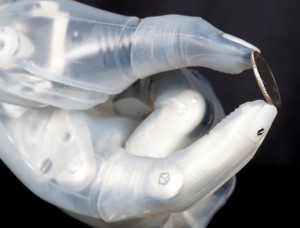Jun
14
Advances in Bionics
Yes, I realize that the title might make you think this post belongs on my “Heroes and Aliens” blog, but this is about the real-world development of “bionic” prostheses and orthoses. Last month, I ran across a list of really cool, recent advances in the field of bionics that I thought would be fun to investigate a bit further and share with my readers. (H/T Dr. Hossein Eslambolchi) I tracked down a few links that will show and explain further the concepts, design, and application of the new tech. It’s some exciting stuff that will be able to help many who have lost (or never had) limbs or have suffered Spinal Cord Injury (SCI). Check it out!
Tendon Transfer: Researchers at Oregon State University and the University of Washington have developed a new tendon transfer surgical procedure that “uses an implanted passive hierarchical artificial pulley mechanism for attaching multiple tendons to a single [undamaged] muscle, in place of directly suturing tendons to the muscle.” They still need a few years to develop biocompatible materials and coatings and such, then more testing. But, the improved natural grasping function (with less muscle energy) will help people recover function lost due to illness or injury.
Neurobridge sensors: A collaboration between The Ohio State University Wexner Medical Center and non-profit Batelle, this new technology bypasses the damaged nerves causing paralysis. The brain’s signals are routed through special sensors implanted in the brain’s motor cortex, where the signals are recoded and re-sent to directly stimulate the muscle via a special “sleeve”.
ReWalk Robotics: Almost a year ago, ReWalk Robotics announced that the FDA had approved the ReWalk Personal System for home and community use. The system is essentially a wearable exoskeleton that helps paraplegics stand and walk by giving powered assistance at the hip, knees, and ankles. “ReWalk provides user-initiated mobility through the integration of a wearable brace support, a computer-based control system, and motion sensors. The system allows independent, controlled walking while mimicking the natural gait patterns of the legs, similar to that of an able-bodied person.”
BiOM: The BiOM T2 System utilizes a battery-powered ankle-foot prosthesis with an internal spring, which compresses to absorb impact and releases to propel the foot forward. “Personal Bionics™ emulates a specific individual’s muscle and tendon function through unique Bionic Propulsion technology. People with amputations now have an ankle device that controls ankle stiffness and power during the stance phase of walking, emulating natural muscle function and enhancing their mobility.” Also, “The device replaces the function of the individual’s lost muscle and tendon anatomy and provides more energy than it stores.”
Intraosseous Transcutaneous Amputation Prosthesis (ITAP): Stanmore Implants is conducting a UK study on a bone implant that provides a secure, easily-accessed, irritation-free attachment point for a prosthetic limb. In other words, no socket required. “This means that loads experienced during daily activities, such as walking, can be taken through the skeleton rather than through soft tissue.” (Note: Current study is only being done on above-knee amputees, as yet.)
Implantable Myoelectric Sensors (IMES): A multi-institutional team, including the Illinois Institute of Technology (see link), has developed a system consisting of “multiple single-channel implanted EMG sensors which provide control signals for control of artificial limbs.” With IMES in each affected muscle, the amputee gains 6-8 degrees of movement at the same time, as opposed to only two degrees provided by surface EMGs.
Tactile feedback: Researchers are developing haptic (i.e., tactile feedback) technology to give a more sensitive sense of touch to a robotic hand (which may eventually be applied to prosthetic limbs). Through a combination of hardware & software, the hand gains the ability to determine an object’s relative hardness or even shape (e.g., round or square).
The Luke Arm: After almost eight years of development and testing, the DEKA Arm System has been approved for commercialization by the FDA. Nicknamed the “Luke Arm” (after Luke Skywalker’s bionic limb in the Star Wars sequels) and funded by DARPA, the system was created by Dean Kamen and his DEKA R&D Corp. “What makes the DEKA Arm unique is that it can carry out multiple, simultaneous powered movements, and its wrist and fingers can adjust its positions to perform six different user-selectable grips. In addition, force sensors let the robotic hand precisely control its grasp…. [S]pecial switches on the user’s feet… wirelessly transmit signals to the arm’s computer, allowing the user to control multiple joints simultaneously.”
Cyborg Beast: For something a little more low-tech for children, try this: an open source-designed, 3D-printed plastic hand that is mechanically controlled by moving one’s wrist or elbow. Heckuva lot cheaper than the usual devices, too!
There are other revolutionary advancements being made, of course, but these nine are probably a good representation of the variety of technologies and approaches being used in this field. Advances like these also represent hope, since they will one day provide or improve not only mobility (including range, flexibility, and normalcy) but also the confidence and independence that goes with it. Plus, there’s that whole potential for superhuman performance that would be pretty cool, too!

















